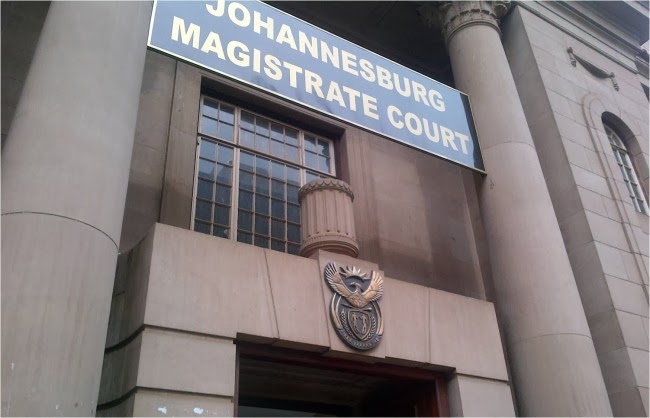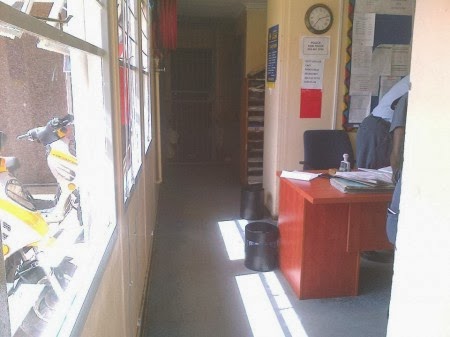Added by Laura Oneale on January 6, 2014.
This is neither the website of, nor affiliated in any way with, Guardian News and Media.
South Africa, Johannesburg on Friday January 3 2014 two young male adults aged between twenty and twenty-three were arrested and caged in separate incidents. The alleged criminals were taken to a local police station and put into a holding cell, measuring approximately one square meter (10.764ft). The victims were held in this small cell, caged like dodgy animals, for over three hours and had no access to bathroom facilities. They were not given water to drink and had to remain seated on a cement floor.
Holding cell, Moffetview Police Station
One youngster was arrested for reckless driving. The arresting police officer alleged that he did not stop at a red robot. The victim’s story was that the robot was not working (which is a common recurring incident in Johannesburg); he yielded and as the road was clear, drove his car across the road.
On Friday, two youngsters, a white man of about twenty-three were walking down the road with his friend, a black youngster. A police car stopped, and two officers approached them.
This is now looked upon as a search and seizure procedure. There are laws surrounding why and how people walking down the streets are approached by police, and they way in which this is tackled does have a conflict with the constitutional rights of the citizens. Within the parameters of the law it is stated for an arrest to be lawful, it must be supported by a probable cause. The police have the right to arrest a suspect if they have reasonable belief that a crime has been committed or the suspect intends committing a crime.
The black teenager was asked to identify himself, and the other lad was asked to empty his pockets. He did not resist and took out a gold ring and cross, with a small pocket knife and handed this to the officer. Immediately after taking possession of the goods, the officer accused him of stealing the property and told him he would be arrested. He tried to explain that it was his property and that he did not steal the goods. The officer then said he would be arrested for possession of drugs. The arresting officer hand cuffed the boy and threw him into the police vehicle. They told the black one back to his home.
Within ten minutes, they arrived at the Moffetview Police Station, and he was taken to a little one square meter section where he met the youngster who was arrested for reckless driving. The arresting officer then went to lunch.
Holding cell, Moffetview Police Station
The alleged victim had access to his cell phone and called his family. Two members of his family arrived at the station within an hour after receiving the phone call. He was still detained in the holding cell, and the family was able to talk to him and try to understand the whole situation. The family was able to talk to some people and try to resolve this misunderstanding.
After several attempts to try to get the youngster out of the caged cell, they had no choice but to call influential people who could assist with this unlawful arrest. The family was told to question the evidence taken from the youngster and why it was not sealed upon the apprehension in his presence. After speaking to people in authority, the station commander said that the arresting officer will present the evidence in due course, and there was no time frame to do this.
It appeared that this is a flaw in the legal system, and if there are no hard and fast rules for submitting the evidence, a fear of being framed could be called for. The South African law states that evidence must be sealed in a notable evidence bag in front of the victim and handed into the police station for investigation.
The arresting officer arrived at the police station about two hours after initially handing in the prisoner. He appeared annoyed and angry when the family questioned him about the reasons for the arrest. The family had no choice but to hire an attorney to prepare bail for the youth’s release.
While waiting for the attorney to appear, the arresting officer handed the gold jewelry to the family and completed his work by submitting his report and evidence. As the victim was caged like an animal in a little inhuman cell, the officer had to move him and get him to a better holding facility at a central police station that had better amenities for prisoners. This is the method until bail is set or until the charged appear in court.
The youngster was taken away after spending more than three hours caged like an animal without water to drink.
The lawyer arrived and immediately began the process of arranging a bail application for the accused. After another hour, with all fees paid, the family could leave and go to the central police station to collect the accused.
On Monday January 6, 2014, the accused, and his mother went to the Johannesburg Magistrate Court for the first appearance. They met with the attorney, who was convinced that he would be able to have the case withdrawn by the state on a technicality.
The family waited outside the court for more than two hours. The attorney representing the accused negotiated with the state prosecutor and successfully had the charges withdrawn. It appeared that the arresting officer had conflicting information in his statement and admitted that a security firm had arrested the boy.
In the South African law, a security guard does not have the power or capacity to arrest a civilian. He could be detained until the police arrive at the scene and on this technicality the case was dismissed.
There was never a doubt that this whole experience was unreasonable conduct by the South African Police who once again, claim to be in control and use the power of the law for their own justice.
Both the arrested youth and the black lad confirmed that there never was any security guards. Strange as it may be, could this be a concocted story by the police to divert attention from the actual truth.
Chapter 2 of the Constitution of the Republic of South Africa Act No. 108 of 1996 headed Bill of Rights provides inter alia as follows:
“Freedom and Security of the person
12. (1) everyone has the right to freedom and security of the person, which includes the right –
(a) Not to be deprived of freedom arbitrarily or without just cause;
(b) Not to be detained without trial;
(c) To be free from all forms of violence from either, public or private sources;
(d) Not to be tortured in any way; and
(e) Not to be treated or punished in a cruel, inhuman or degrading way.”
Snapshot of Cell Conditions South Africa
Having the constitution to protect the human rights of all individuals is a comforting fact but having a police force that uses the law to rise about the human rights of a person is hell. The sheer thought of innocent victims being detained in a cell like a caged animal is traumatising enough for the victim.
Story by Laura Oneale
Sources:







No comments:
Post a Comment